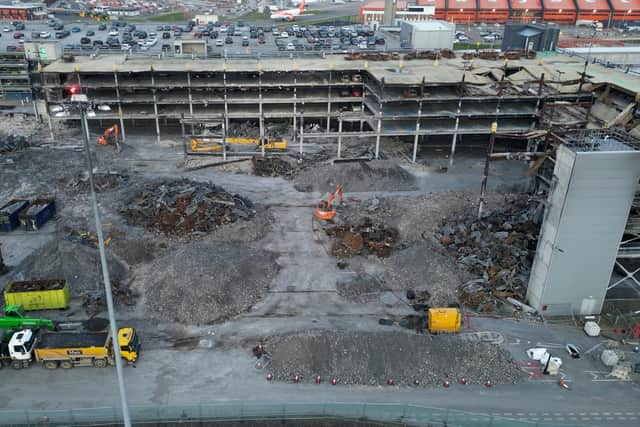Watch as drone footage shows progress made to demolish Luton airport car park six months on from devastating fire
and live on Freeview channel 276
Six months on from a huge fire that destroyed one of Luton airport’s main car parks, drone footage has captured the progress made to demolish the burnt structure.
So far, more than 60 per cent of the car park has been dismantled, and three-quarters of the 1,300 vehicles affected have been removed. The demolition is expected to be completed next month.
Advertisement
Hide AdAdvertisement
Hide AdAs of yesterday (April 8), 790 tonnes of metal have been taken from the site and recycled, and the concrete wasted has been crushed and reused.


The multi-storey car park went up in flames on October 10 last year. At its height, more than 100 firefighters tackled the fire, with aircraft grounded until the following day.
The rebuild of a new four-storey car park will begin later this year, but until then a replacement one will have space for nearly 2,000 vehicles and will have a ground level drop-off zone. As well as meeting all necessary fire and safety regulatory requirements, the new car park will use a fire suppressant system.
Once completed in late 2025, the airport’s short-term car parking capacity will go back up to around 4,000 vehicles. A temporary drop-off zone is being put closer to the terminal is being developed and is expected to open this summer. For now, a free drop-off and pick-up zone continues to
Advertisement
Hide AdAdvertisement
Hide Adoperate from the mid-stay car park - a short walk to the terminal building with a frequent shuttle bus service.
Alberto Martin, CEO at London Luton Airport said: “The dismantling of the car park has been a precise and painstaking process, and its proximity to passengers, buildings, aircraft and the Luton DART railway station has added to the project’s complexity.”
This news comes as the fire service determined that the fire was most likely started accidentally. A report from Bedfordshire Fire and Rescue service read: “As a result of the investigation, all evidence points to the most probable cause being an electrical fault or component failure, which started in the engine bay of the vehicle whilst it was in motion.
“The developing fire spread to other components, and whilst the owner of the vehicle attempted to fight the fire, the vehicle became overrun with flames and spread to other parked vehicles.”
